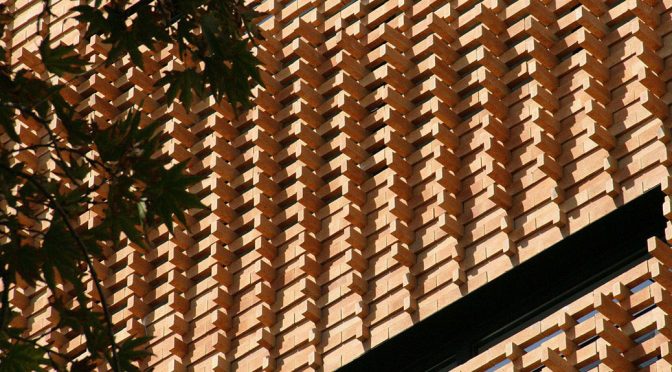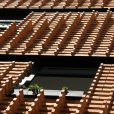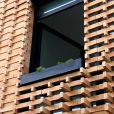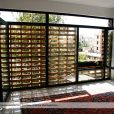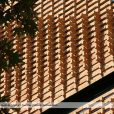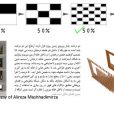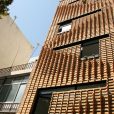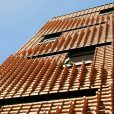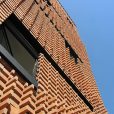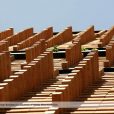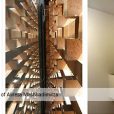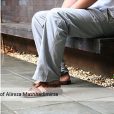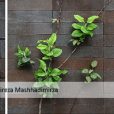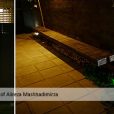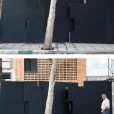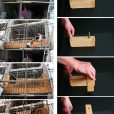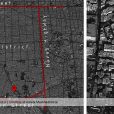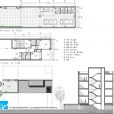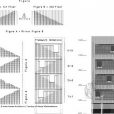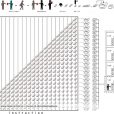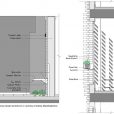خانه آجربافت
علیرضا مشهدیمیرزا
موقعیت: تهران، ایران
تاریخ: ۱۳۹۰
وضعیت: ساختهشده
ﺟﻮاﻳﺰ: رﺗﺒﻪ سوم ﮔﺮوه مسکونی جایزه ﻣﻌﻤﺎر ۱۳۹۰
ساختمانی که قرار بود طراحی کنیم، یک نما بیشتر نداشت: نمایی به عرض ۶ متر و ارتفاع حدود ۱۵ متر. برای ایجاد سایههای متنوع روی نما و کنترل نور، تصمیم گرفتیم نمایی سهبعدی طراحی کنیم. محدودیتهای پروژه، از نظر متراژ و عدم امکان ایجاد تراس و فضای منفی در نمای خارجی، باعث شد از حداقل عمق لازم برای ایجاد نمای سهبعدی استفاده کنیم و بدون از دست دادن متراژ بنا، این نما توسط بافت آجری ایجاد شود.
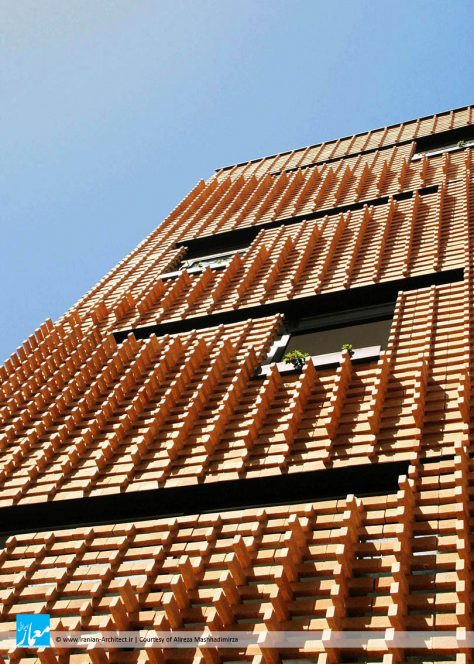
با توجه به کم بودن حقالزحمه در این پروژه، میبایست روشی ابداع کنیم که نیاز چندانی به نظارت یا تولید نقشههای جزئیات اجرایی نداشته باشد؛ بنابراین کلیه ملزومات اجرایی در یک دستورالعمل که مبنای آن اعداد و ارقام ریاضی است، خلاصه شدند. اسم این روش را ۲۳ گذاشتیم، چون همه گزینهها در آن با عدد ۲۳ شناخته میشوند: ۲۳ ردیف آجر، ۲۳ اندازه آجر برشخورده، ۲۳ کارتن آجر، ۲۳ ستون میلگرد که استراکچر نما بوده و آجرها به ترتیب داخل آن قرار میگیرند.
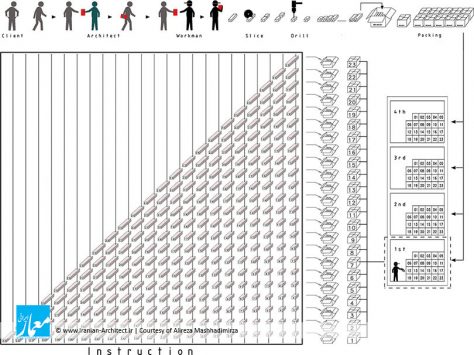
در این روش، مطابق دستورالعمل که معادل یک برگ A4 است و به کارفرما ارائه میشود، کارفرما میبایست 23 جعبه برای هر طبقه تهیه کند. روی هر جعبه، از عدد ۱ تا ۲۳ کدگذاری میشود و داخل هر جعبه، مطابق جدول دستورالعمل، آجرهای برشخورده قرار میگیرند. این ۲۳ جعبه در هر طبقه قرار گرفته و کارگر جعبهها را به ترتیب، از جعبه شماره ۱ باز کرده و آجرهای آن را به ترتیب اعداد، در هر ردیف داخل میلگرد کرده و به صورت خشکهچین روی هم قرار میدهد. این روش، مانند اجرای پازل است که پشت قطعات پازل شمارهگذاری شده و مجری بدون اینکه حتی متوجه باشد، با استفاده از ارقام و اعداد، چیدمان را انجام میدهد. معمار میتواند بدون نظارت مستمر، با نیروی غیرمتخصص و بدون صرف هزینههای مازاد، در مدت زمانی کوتاه، نماهایی پیچیده از این قبیل را طراحی و اجرا کند.
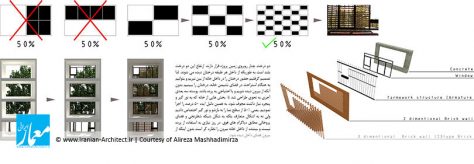
دو درخت چنار روبروی زمین پروژه قرار دارند؛ ارتفاع این دو درخت بلند است، به طوری که از داخل هر طبقه درختان دیده میشوند. لذا تصمیم گرفتیم حضور درختان را در داخل خانه از بین نبریم و بتوانیم به هنگام استراحت در فضای نشیمن خانه، درختان را ببینیم، بدون آنکه از بیرون دیده شویم یا احتیاجی به پرده باشد. پوسته سهبعدی آجری به نحوی طراحی شد تا بخشهایی از خانه که به نورگیر و پنجره نیاز داشت، مجوف شود. به همین دلیل، ایده ۵۰ درصد را اجرا کردیم، یعنی ۵۰ درصد از سطح نما را به بازشو و نورگیر اختصاص دادیم، ولی نه به اشکال متعارف، بلکه به شکل شبکه شطرنجی و فضای پر و خالی، مطابق دیاگرامهای فوق. در روز، نیازی به استفاده از پرده نیست و بیینده از داخل، بیرون را نظارهگر است، بدون اینکه از بیرون، فضای داخل دیده شود.
Brick Pattern House
Alireza Mashhadimirza
Finalist of Iranian Architect Merit Award 2018
Finalist of Iranian Architect Merit Award 2018
Location: Tehran, Iran
Date: 2011
Status: Completed
Awards: 3rd Place of Memar Award 1390
The building is located in a very poor area of our city and has been built on a low budget. The design fee was barely enough for the phase 1 drawings. Therefore, we have decided to create a method that does not need any phase 2 drawings; the result was eliminating extra costs of supervision and producing detail drawing. The limits of the design fee did not make us to ignore the details, instead, we have found a way to pay more attention to details and designing complicated details, in a very simple way.
The building has 4 floors, each 62 sqm, in a plot size of only 130 sqm. In this aspect, the facade carries a social message and shows that even in areas like this, with a small budget, we can have an architectural effort. In our country, labor wage is proportionally low and the possibility of creating special designs on smaller scales is more than developed countries. In this project, we tried to be creative on using local labors and show how valuable a brick facade could be. Although brick is a traditional material in our historical architecture, the result does not look traditional. The inventive method of using brick has given a new value to this traditional material. A great effort has been put in the execution process to make a special brick job, in a new approach.
The building that we were planning to design, had only one facade. The facade had a 6 meter width and a 15 meter height. To create the different shadows on the façade and control the light, we decided to design a 3D façade. We had some limitation in our project, in respect of size and not having the possibility to have balconies or negative space on the external facade, it made us use the minimum depth needed to create a 3D brick texture facade without losing any space. The bricks have been placed in a specific manner to control the sunlight and keep the building cool. The 3D brick shell acts as a mesh which creates shadows both on the external façade wall and the interior space .This mesh reduce the sun radiation and will help energy saving during summer, in a hot climate with high sun radiation.
The 3D brick wall has also a cultural value. In our country, people care so much about privacy in their houses and they usually use curtains to block the windows. Therefore, they will miss the outside view .With this semi-transparent brick wall there is no need to put curtains and we can still have outside view. Two existing plane trees facing the facade can be seen very closely from the living rooms of each floor.
In respect of the low budget, we needed to create a method which does not make us produce lots of executive drawings or does not need a great amount of time for supervision. So, the whole executive process was condensed in an instruction which is based on numbers and digits. We named this instruction “Method 23”, because everything is associated with the number 23: 23 brick rows, 23 sliced bricks, 23 boxes of bricks, and 23 columns of structural supports.
In this method, an instruction in only one A4 page is given to the client. According to this instruction, the client obtains 23 brick boxes. Each box contains the numbered and sliced bricks. As it is shown in the chart, for example, there will be 23 bricks in the first box from No. 1 to No. 23 and in the 23rd box, there will be only one brick which is brick No.23. All the bricks are drilled like it is shown in the picture. The 23 boxes will be placed in each floor. The workman will first open the box No. 1 and will put the bricks in to the framework from number 1 to 23. The same job will be done for all the boxes and all the floors. This method is like putting together pieces of a simple puzzle; each piece has a code and it is easy to put it in right place. So, this method will lessen the need for supervision and the installation can be done in a short time and by unprofessional workers. As a result, the execution cost will decrease.

